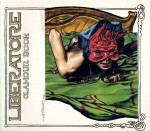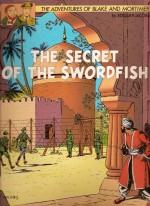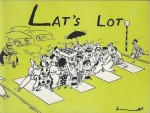
By Francisco Solano López &Barreiro (Eros Comic/Fantagraphics)
ISBN: 978-1-56097-202-0
This book is intended to excite adults whilst simultaneously making them laugh, think, and hopefully feel frisky. If the cover image hasn’t clued you in, please be warned that the book contains nudity, images of sexual intimacy but, oddly, not the sort of language commonly used in the privacy of the bedroom (and playgrounds whenever supervising adults aren’t present). If this sort of thing offends you, read no further and don’t buy the thing. The rest of us will just enjoy one of the best graphic novel experiences ever created without you.
Whilst prolific scripter Ricardo Barreiro prefers to quietly let his prodigious works speak for him, his inimitable partner in this and many other comics classics is an unmistakable part of three generations of kids’ lives.
For British and Commonwealth comics readers of a certain age, the unmistakable artistic style of Francisco Solano López always conjures up dark moods and atmospheric tension because he drew such ubiquitous boyhood classics as Janus Stark, Adam Eterno, Tri-Man, Galaxus: The Thing from Outer Space, Pete’s Pocket Army, Nipper, The Drowned World, Kelly’s Eye, Raven on the Wing, Master of the Marsh and a host of other stunning tales of mystery, imagination and adventure in the years he worked for Britain’s Fleetway Publications.
However the master of blackest brushwork was not merely a creator of children’s fiction. In his home country ofArgentinahe was adjudged a radical political cartoonist whose work eventually forced him to flee to more hospitable climes and far less dangerous times.
Francisco Solano López was born on October 26th 1928 in Buenos Aires, Argentina and began illustrating comics in 1953 with Perico y Guillerma for the publisher Columba. With journalist Héctor Germán Oesterheld (a prolific comics scripter “disappeared†by the Junta in 1976 and presumed killed the following year) Solano López produced Bull Rocket for Editorial Abril’s magazine Misterix.
After working on such landmark series as Pablo Maran, Uma-Uma, Rolo el marciano adoptivo and El Héroe, López joined Oesterheld’s publishing house Editorial Frontera and became a member of the influential Venice Group which included including Mario Faustinelli, Hugo Pratt, Ivo Pavone and Dino Battaglia.
López alternated with Pratt, Jorge Moliterni and José Muñoz on Oesterheld’s legendary Ernie Pike serial but their most significant collaboration was the explosively political and hugely popular allegorical science fiction thriller El Eternauta which began in 1957. By 1959 the series had come to the unwelcome attention of the authorities inArgentina andChile, forcing López to flee toSpain. Whilst an exile there he began working forUK publishing giant Fleetway fromMadrid andLondon.
In 1968 he returned to Argentinaand with Oesterheld started El Eternauta II for new publisher Editorial Records, produced sci-fi series Slot-Barr (written by Barreiro) and period cop drama Evaristo with kindred spirit Carlos Sampayo. In the mid-1970s López was once again compelled to flee his homeland, returning to Madrid where he organised the publication of El Eternauta and Slot-Barr with Italian magazines LancioStory & Skorpio.
He never stopped working, producing a stunning variety of assorted genre tales and mature-reader material and erotica such as El Instituto (the subject of this review under its American title Young Witches), El ProstÃbulo del Terror (also by Barreiro) and full colour male-fantasy strip Sexy Symphonie.
More serious works included the bleak thrillers Ana and Historias Tristes with his son Gabriel and he also illustrated Jim Woodring’s adaptation of the cult movie Freaks. In recent times, safely home in Argentina he continued to work on El Eternauta with new writer Pablo “Pol†Maiztegui.
López even found time for more British comics with strips such as ‘Jimmy’, ‘The Louts of Liberty Hall’, ‘Ozzie the Loan Arranger’ in Hot-Shot and Eagle as well as ‘Nipper’ and ‘Dark Angels’ for Roy of the Rovers.
Francisco Solano López passed away in Buenos Aireson August 12th 2011.
Latterly his most famous English-language series (six volumes of stunning, shocking erotically charged graphic novels at the last count), The Young Witches debuted in the USA as a 4-issue miniseries from Fantagraphics’ Eros Comics imprint in 1990, the contents of which form the majority of this superbly seductive compilation.
In the winter of 1866, after a troubled labour which took her mother, Lillian Cunnington was born into a minor aristocratic house. When her father, barely married seven months, realised how he had been cuckolded and subsequently took his own life, the baby was sent to live with her maternal aunts Jessica and Agnes Moore inCoventry.
Lilian’s life was harsh and bizarre, growing up with the draconian spinsters who revelled in the era’s taste for corporal punishment and had an entirely unnatural and abiding affection for each other which they frequently indulged, uncaring if impressionable eyes were watching…
In the Spring of 1881 the wilful, self-reliant child was bundled off to a finishing school where she discovered the truth about her past and the secret history of the world…
The Institute was a forbidding edifice set in vast, isolated grounds that took only the most select young girls. After passing a terrifying and shockingly intrusive entrance exam, young Lilian discovered that the school was a haven and training ground for the last remnants of an ancient sub-race of humanity: women with astonishing supernatural abilities…
The other girls were alternately hungry to meet her and resentful – especially as her mother fled the order and abandoned their millennial principles – but when they forcibly subjected her to their own disturbing initiation rites Lilian repulsed them all with an explosive display of unsuspected arcane power…
In her decidedly unconventional classes she learned the history of her kind: how in time-lost Sumer the cult of Ishtar, the Female God was first born, a religion for women which bestowed great power and knowledge on its adherents.
As Aphrodite in Greece and Venus in Rome, the faith continued until the rise of monotheistic Male Christianity sought to enslave and humble women and wipe out the powerful, wanton deviants they termed witches…
Driven into hiding the witches were almost eradicated by the 18th century, when the solitary prophetess Diana had a revelation and began seeking out sister-survivors, believing them by the very fact of their continued existence to be superior beings, honed to a Darwinian fitness.
Drawing them together she devised a plan of conquest to take control of the world by manipulating men of power, wealth and influence, using their addiction to pleasure and the witches’ divine gifts. Through careful planning, judicious infiltration and sublime seduction, the women would subjugate their cruel oppressors…
The work of the institute was to train girls to be the perfect wives of the world’s rulers, using sex as a weapon and clandestinely controlling from the bedroom. Meanwhile the ultimate goal was to produce ever-more powerful witches by only breeding daughters. To accomplish their sacred plan however, the institute harboured two horrific secrets: a thriving trade in selling ideal brides to the debauched scions of theBritish Empire- and the lesser World – and a hideously inbred brood-male who covertly inseminated every girl before her wedding night, ensuring that wherever they ended up Ishtar’s bloodlines remained pure…
Lilian was a problem however. Although the daughter of a failed traitor to the cause, she was also the most powerful witch the school had ever encountered and her rebellious nature was seemingly impervious to reason, discipline or correction.
Moreover she was unwholesomely attracted to young men such as the gardener rather than her own sisters and kind, with no machinations the girls or their grotesquely conniving headmistress could devise able to dissuade her from her disobedient path…
Events came to a cataclysmic head when her rival and classmate Agatha was betrothed.
Ready to go forth and do the Cult’s bidding as bride of aged Lord Wellington, the dutiful disciple was appalled at her impregnation ceremony when confronted by the Institute’s shambling, brutish imbecilic stud male. Agatha baulked and broke down, refusing to commit the act and the enraged Headmistress compelled her with all the violence and brutality she has claimed to be the province of their male oppressors…
Lilian exploded in a display of outrage and indignation and with all the power of the elements the Young Witch lashed out against a lifetime of control, virtual slavery and injustice resulting in a deadly duel of magical will and an apocalyptic conflagration…
In the aftermath Lilian and Agatha fled the shattered Institute forever…
Let’s not stray from the point – these tales are primarily designed to honestly titillate and excite and there’s a huge amount of lavishly rendered nudity, love-making and fetishism on display here. However there is also a strong story, terrific suspense and a heartfelt attempt to say something about gender politics too, and all in a well-researched historical context.
In later tales Lilian and Agatha have encounters with iconic historical and literary figures including Robert Louis Stevenson, Sigmund Freud, Albert Einstein, Dr. Henry Jekyll (plus one), Jack the Ripper, Dorian Grey, Sherlock Holmes and others…
This deliciously saucy and salacious sex-and-horror yarn combines the bawdy, breezy, haunted ambiance of classic Hammer Films with sultry, lascivious supernatural suspense in a stunning black and white confection far more enchanting and compelling than any number of shades of grey, and this torrid tome also includes a luscious, full-colour extra erotic charge in the form of a silent, sexy Silly Symphony from Solano López…
© 1990, 1991, 1992Barreiroand F. Solano López. All rights reserved.










